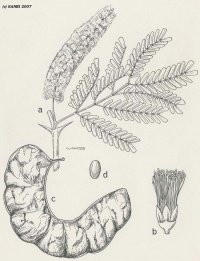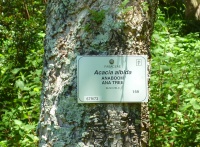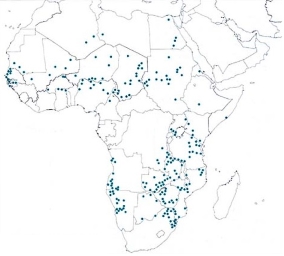Acacia albida (Faidherbia albida)
Contents
General Plant Info
Sacred tree in Judaism, known as 'Anna Tree' or Winter Thorn.
Geographic distribution
Middle-east: Israel, Lebanon, Jordan and Yemen.
Africa: from Senegal to Ethiopia, and southwards through East Africa to the Transvaal and Lesotho, most common in Sudan.
Identification
Bark: Characteristically dull brown to whitish grey, smooth when young, more fissured and flaky and more cork-like in older specimens. The slash is fibrous, pink to light brown (Wood 1992: 9).
Spines: Paired, stipular in origin, moderately thick and straight, up to 1.5-2.3 cm long, frequently directed slightly downwards, white to grey with brown base, base rarely slightly enlarged; spines crowded on new growth, fine and frequently tinged with orange or light brown at the tips, absent or vestigial on old growth; no prickles present (Wickens 1969: 182). They may be distinguished from those of Acacia species with long thorns, such as A. tortilis subsp raddiana, A. nilotica, or A. seyal, by their basal thickening (Wood 1992: 10).
Leaves: Compound and bipinnate with leaflets borne along the pinnae. They are highly variable: the petiole varies from 0.5-3.7 cm long. The rachis is 3-7.5 cm long and carries 2-12 pairs of pinnae, each of which is 2.5-5.5 cm long (Wood 1992: 9-10).
Leaflets: Grey-blue-green, 4-23 pairs per pinna (varies by region) (Wickens 1969: 182).
Flowers: The flowers are borne in dense axillary panicles 3.5-16 cm long, with a peduncle 2-4 cm long. They appear about 2 months after the tree comes into leaf and are sessile or with a pedicel of up to 2 mm. In color they are successively white, cream, and then yellow, and are strongly perfumed (Wood 1992: 10). Flowering commences towards the seventh year (Nongonierma 1976; McGahuey 1985).
Seed pods: Indehiscent pod varying from bright orange to reddish brown and 7-9 mm thick, 6-35 cm long, and 1.4-6 cm wide. It falls from the tree about 3 months after flowering. The pod surface is convex on one side and becomes concave on the other, and as the fleshy mesocarp lignifies, it tends to roll into a spiral resembling dried apple peel, hence the common name "Apple Ring Acacia". There is much variation in pod shape both within and between trees (Wood 1992: 10).
Seeds: Each pod contains 10-29 dark brown shiny seeds, separated by thin septa. They are ovoid, 10 x 6 mm in size and are characterized by an elliptic areolus or hilum measuring about 8 x 5 mm. The seed coat is tough, waterproof, and leathery, and maintains seed viability for many years (Wood 1992: 10).
Alkaloid content
Reported by several sources in Israel to contain DMT in leaves and bark, including official channels.
Other uses
Faidherbia albida provides many useful products, the main ones being wood, foliage and pods. The pods and foliage are a valuable source of fodder for both livestock and wildlife, especially as both are available at the end of the dry season when there is little other available forage. The pods have a high protein content, but at times they contain a toxin when unripe. This can be removed by boiling (Spicer et al. 2003: 128). Other uses include as cattle fodder, for nitrogen fixation, and silverculture.
Barks, roots and crushed pods have been used as a fish poison.
Medicinal: Faidherbia albia has many medicinal properties (Watt and Breyer-Brandwijk 1962; Dancette 1968; Fanshawe 1972; Lamprecht 1989). Extracts of the bark, gum and roots are the main parts used to treat many ailments (Barnes and Fagg 2003: 41-42).
Extracts are used as astringents to treat gastrointestinal disorders, particularly diarrhoea (William son 1956; Watt and Breyer-Brandwijk 1962; Kokwaro 1976; Timberlake 1980; Wickens 1980; Muhammed et al. 1998). Spicer et al. (2003: 128) state the additional use of the bark in traditional medicine against bleeding, inflammation of the eyes and as an emetic.
There is widespread use of the bark to prepare a bronchoemollient for respiratory diseases (Wickens 1980; Anon. 1982a; Bonkoungou 1987). Bark and root preparations are also said to have anti-febrile (anti-malarial) properties (Irvine 1961; Wickens 1980; Anon. 1982a; Bongkoungou 1987).
Other ailments that are treated with preparations from the bark include liver complaints, wounds, ulcers, psychological disorders, kidney diseases, post-partum complications, haemorrage, rheumatism, ear-ache and deafness, colds and gripe (Irvine 1961; Anon. 1982a; Wickens et al. 1995).
Leaves used for colds, ophthalmia and as an astringent for the teeth and may contain fluorine (Barnes and Fagg 2003: 42; Hutchings et al. 1996; Watt and Breyer-Brandwijk 1962; Wickens et al. 1995).
Extraction
Cultivation
Germination: Seeds, which can be collected from August onwards, germinate readily after pre-treatment, but there is much variability in germination (Spicer et al. 2003: 128).
Propagation: Cuttings set in sand can give up to 65% establishment (Spicer et al. 2003: 128).
Soil: Suited to sandy alluvial soils. The species is tolerant of saline soils, periodic waterlogging and fire. It can grow on some slightly toxic soils, but does not do well in alkaline soils (Spicer et al. 2003: 128).
Growth: Trees of this species can live to over 100 years. Growth is rapid, particularly once the taproots reach the water table. The trees have a long taproot. Rapid early growth means that trees can reach a height of 7 metres in 3 years. Young trees coppice readily. Once established, plants are tolerant of cold but not of frost (Spicer et al. 2003: 128).
Suppliers
Links
References
Barnes, R.D. & Fagg, C.W. 2003, Faidherbia albida: Monograph and Annotated Bibliography, Oxford Forestry Institute, Department of Plant Sciences, University of Oxford.
Dancette, C. & Poulain, J.F. 1969, "Influence of Acacia albida on pedoclimatic factors and crop yields", African Soils, vol. 14, pp. 143-184.
Fanshawe, D.B. 1972, "Acacia albida Del." in Useful Trees of Zambia for the Agriculturalist Ministry of Lands and Natural Resources, Lusaka, Zambia, pp. 58-59.
Hutchings, A., Scott, A.H., Lewis, G. & Cunningham, A.B. 1996, Zulu Medicinal Plants: An Inventory, University of Natal Press, Pietermaritzburg.
McGahuey, M. 1985, Impact of forestry initiatives in the Sahel on production of food, fodder and wood, Chemonics International, Washington, D.C.
Muhammad, S., Mushtaq, A. & Ashfaq, A. 1998, "Chemistry of the medicinal plants of genus Acacia", Hamdard Medicus, vol. 41, no. 1, pp. 63-67.
Nongonierma, A. 1976, "Contribution a l'etude bio-systematique du genre Acacia Miller en Afrique occidentale. II. Caracteres des inflorescences et des fleurs.", Bulletin IFAN, vol. 38, pp. 487-642.
Spicer, N., Barnes, R. & Timberlake, J. (eds) 2003, Acacia Handbook: Growing and Managing Acacias in South Central Africa, CBC Publishing.
Timberlake, J. 1980, Handbook of Botswana Acacias, Division of Land Utilization, Ministry of Agriculture, Botswana.
Watt, J.M. & Breyer-Brandwijk, M.G. 1932, The Medicinal and Poisonous Plants of Southern Africa: Being an account of their medicinal uses, chemical composition, pharmacological effects and toxicology in man and animal, E. & S. Livingstone, Edinburgh.
Wickens, G. 1969, "A Study of Acacia albida Del. (Mimosoïdeae)", Kew Bulletin, vol. 23, no. 2, pp. 181-202.
Williamson, J. 1956, Useful plants of Nyasaland, The Government Printer, Zomba, Nyasaland.
Wood, P.J. 1992, "The botany and distribution of Faidherbia albida." in Faidherbia albida in the West African semi-arid tropids: proceedings of a workshop, 22-26 Apr 1991, Niamey, Niger, ed. R. Vandenbeldt, International Crops Research Institute for the Semi-Arid Topics, Patancheru, India, pp. 9-17.


